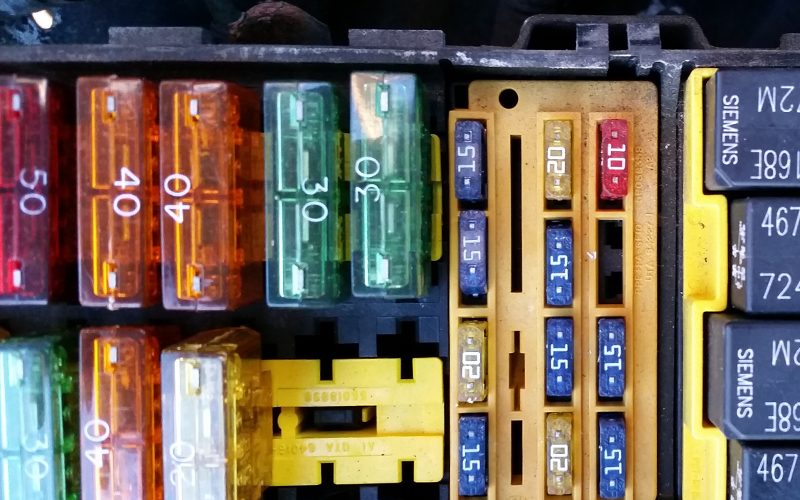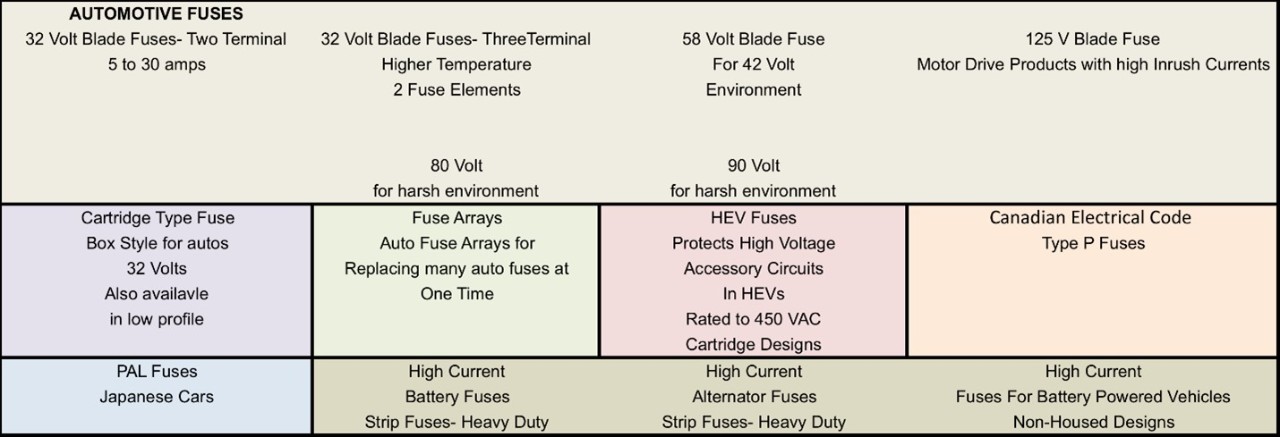
Introduction
A fuse is an electrical or electronic circuit protection device that protects a circuit against overcurrent, either by melting or fusing open its conductive element when excessive current flows through it. Some fuses are single-use or “one-shot” designs; others are reusable designs. This is an important distinction in the marketplace among design engineers.
The combined dollar value of all fuse products, electrical and electronic, will represent about $2.2 billion in global revenues for 2020. While many markets for fuses see growth in electronic, industrial and transportation markets, the transition to battery electric vehicles will have the greatest impact on fuse value as requirements shift from traditional blade designs to more robust parts with higher voltage handling in harsh environments.
Fuse Components by Type
In the field of electronic fuses, the configurations employed are typically miniature and micro-fuses that contain cylindrical or square bodies with ferrule end caps, terminations or leads. These components have a rating from several milliamperes to tens of amperes, with voltage ranges from a few volts to 500 volts.
Automotive fuses can be considered a subset of the electronic micro-fuse business segment based upon their operating parameters. Also, because of their unique configurations (i.e. blade design) and operating environments, we can consider them as a separate market segment. This market is also giving way to the need for industrial fuses to handle the high voltages of the battery electric vehicle market, specifically for applications in the battery management system (BMS).
Larger-type industrial fuses designed to handle extremely high currents at high voltages are also available, and are also considered a separate market because of the associated channels and customer base; they represent a significant amount of revenue for fuse vendors worldwide. Industrial-grade fuses are also in the spotlight because of their use in protecting high voltage electrical bus systems in electric transportation.
The combination of high voltage and high reliability required for electric transport has created as valuable and rapidly growing sub-segment of the global industrial fuse markets.
Electrical and Electronic Fuse Components by Technology
Ultimately, there are two basic forms of fuse technology: single-element fuses and twisted pair element fuses.
Single-element fuses employ a metallic wire inside a suitable enclosure, usually glass or ceramic. The metallic wire is the fusible element; this element responds to increased temperature. The fuse becomes part of the circuit and is subjected to the current flowing through the circuit. During an overcurrent situation, the fuse reacts quickly to the rise in temperature. This process results in an open circuit and protects sensitive electronics downstream.
Twisted pair element fuses, on the other hand, are manufactured by using two metallic wires made up of different metallic elements of unlike materials, twisted together so that they become a compound element. The two types of wires have different temperature coefficients and melting points. Twisted pair element fuses are used in medium time-delay fuse designs because they respond more slowly to an overload event when compared to single-element fuses. This increases the reliability and sensitivity of the fuse and creates a more precise reaction.
An Overview of Fuses by Configuration
Surface Mount Chip Fuses (Thick and Thin Film)
These designs represent a significant amount of revenue for fuse vendors in their molded chip, solid ceramic matrix and thin film surface mount designs. In solid matrix or “thick film” designs, the fusible link is enclosed in a ceramic filler material which is placed in the fuse package – completely closed to outside elements and soldered into the circuit requiring overcurrent sensing.
Surface mount fuses represent one of the fastest growth portions of the subminiature fuse business, and are typically purchased in 63VDC-rated packages, but may be found as high as 125VDC. SMD fuses are now available in standard footprints from the ultra-small 0402 to the very large 6125 footprints.
Subminiature fuses are consumed in telecommunications applications, personal computers, household appliances, switch mode power supplies, input/output modules, video game consoles and medical electronics.
Technology in thick film ceramic fuses has given way to thin film surface mount fuse technology, which is more sensitive and which offers the design engineer a ultra-small footprint of 0402 in case size.
Figure 1: Molded, Thick Film and Thin Film Chip Fuse Types and Variations

Source: Compiled by the author from company websites
Miniature Glass Cartridge Fuses
Axial leaded-glass cartridge fuses are typically sold in 5x20mm and 6.3x32mm footprints. They are popular because they can be easily replaced by the end user when used in conjunction with standard, high-temperature, shock-resistant thermoplastic fuse holders. The core of the fuse may be either glass or ceramic, with nickel-plated brass end-caps.
The rated voltage for glass cartridge fuses varies, but generally will fall into the 250Vdc range; but higher voltage products in the 350, 440 and 500Vdc range are also widely used. Typical rated current handling capacity of miniature cartridge fuses are in the 32mA to 16.00A range.
Miniature glass cartridge fuses are generally used in switch mode and other power supplies; lighting ballasts, consumer audio and video imaging equipment; household appliances; medical electronics equipment; measuring instruments and industrial controls.
Figure 2: Glass and Ceramic Cartridge Fuses by Type and Application

Source: Compiled by the author from company websites
Axial and Radial Leaded Micro-Fuses
Axial and radial leaded micro-fuses contain fuse elements molded into thermoplastic resin or an aluminum housing. These designs are typically used in harsh environments and are tested to mil-spec standards for shock, vibration, moisture and corrosion resistance.
Axial and radial leaded fuses can be considered legacy and/or custom components since the development of solid matrix fuses. These axial and radial leaded fuses usually find their applications in custom markets for defense, instrumentation, power, HVAC and specialty laboratory instruments.
Automotive Blade Fuses and Strip Fuses
Fuses consumed in automotive electronic subassemblies are either blade fuse or strip fuse types, required to operate in low voltage and high current applications in the mass ICE (Internal Combustion Engines) sedan and light truck markets (Class 3 to 7).
Automotive electronic subassembly manufacturers have standardized these fuses into small, medium and large size categories. These devices are generally sold in 32VDC, 80VDC and 125VDC ratings. The current handling capability of these fuses are typically in the 500mA to 50A ratings for blade fuses; 40A to 300A for strip fuses. A standard ICE car has an average of 35 blade fuses and an average of 15 strip fuses.
Automotive fuses are used in automotive electronic subassemblies such as ABS cards, engine control units, audio systems, navigation systems, security systems and other related automotive electronic subassemblies. However, due to the low-voltage, high-current aspects of these devices they are also used in telecommunications equipment, cable television, computers, household appliances and standby power supplies.
Automotive grade fuses are required for the protection of individual automotive accessories (through the fuse box), batteries and alternators. The following chart illustrates the various types of automotive fuses. Auto fuses will vary based on type, configuration, voltage, amps and performance characteristics, as shown and discussed below.
Figure 3: Automotive Fuse Variations by Type

Source: Compiled by the author from company websites
Electric Vehicle Fuses
One of the fastest growth segments of the global fuse market is for industrial grade fuses consumed for battery module protection in battery electric vehicles (BEVs). Many of these designs are offshoots of DC protection for forklifts; fuses for BEVs are rated to 500VDC at up to 150 amps.
Industrial-Grade Power Fuses
Power fuses are used in high amperage and high voltage applications, typically from 400VDC to 1,000Vdc in load-centers, panelboards, switchboards, bus ducts, feeder circuits, non-inductive loads, and HID lighting circuits. Smaller physical variations are also used in industrial motors and motor controllers (a large market). These are one-time use fuses that are fast acting and constructed to handle serious overcurrents to protect sensitive power related equipment.
The chart below illustrates the various types of industrial fuses. This is a significant market segment, and the fuse variations are based largely on increasing levels of amperage and more demanding end-product applications in the power transmission and distribution infrastructure.
The reader can ascertain from the chart below, the various end-product applications that require industrial fuses. For example, we note that fuses are required throughout the power supply chain – especially for protection of motors, circuit breakers, transformers, meters, solenoids, speed drives and lighting ballasts
Figure 4: Industrial Fuse Configurations and Sample Applications

Source: Paumanok Publications, Inc. Please note that even though the UL lists fourteen variations of industrial fuses; most manufacturers supply six variations, including class L, class RK1 and RK5, Class J, Class CC, Class T and then the supplemental fuses.
Polymer PTC Resettable Fuses
Polymer PTC resettable fuses are made of conductive particles, such as carbon, scattered in a polymer matrix. Under normal operating conditions, little I2R heat is generated and the conductive particles remain in close contact. When overcurrent occurs, the polymer heats above its transition temperature and the polymer matrix expands, causing the conductive particles to lose contact which sharply increases device resistance. PPTC thermistors are the fastest growth portion of the global fuse business because of their low price and resettable nature.
The following table illustrates specific applications for PPTC resettable fuses by end-use market segment and specific product applications within each segment. PPTC components target specific markets that have been dominated by solid fuses for many years.
Figure 5: Telecom, Computer, Industrial, Appliance, Automotive, Consumer and Specialty Applications for Polymer PTC Resettable Fuses

Source: Compiled by the author from company literature
Statements of fact and opinions expressed in posts by contributors are the responsibility of the authors alone and do not imply an opinion of the officers or the representatives of TTI, Inc. or the TTI Family of Companies.
